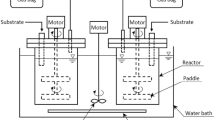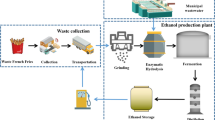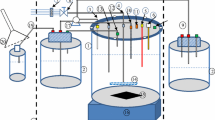Abstract
An integrated ethanol–methane fermentation coupled system characterized with full wastewater reutilization was proposed. The waste distillage originated from ethanol distillation was treated with anaerobic digestion and then recycled for medium preparation in the next ethanol fermentation run. This process could enhance wastewater reutilization, save fresh water and reduce energy consumption in the cassava-based ethanol production. The results indicated that, when using anaerobic effluents from the digestion process with only one tank, an ethanol concentration of 10.5% (v/v) compatible with that of conventional one could be achieved, but ethanol fermentation was partially inhibited and operation time gradually prolonged from 48 to 105 h. Using anaerobic effluents from the digestion process with two subsequently connected tanks, ethanol fermentation performance could be largely improved, and the fermentation lag could be completely eliminated. The performance enhancement was due to the concentrations reduction in organic acids, such as acetic and propionic acids in the digestion effluents using two digestion tanks in-series.





Similar content being viewed by others
References
Pant D, Adholeya A (2007) Biological approaches for treatment of distillery wastewater: a review. Bioresour Technol 98:2321–2334
Wu CZ, Yin XL, Yuan ZH, Zhou ZQ, Zhuang XS (2009) The development of bioenergy technology in China. Energy 1–6
Sanchez OJ, Cardona CA (2008) Trends in biotechnological production of fuel ethanol from different feedstocks. Bioresour Technol 99:5270–5295
Bothast RJ, Schlicher MA (2005) Biotechnological processes for conversion of corn into ethanol. Appl Microbiol Biotechnol 67:19–25
Kunz M (2008) Bioethanol: experiences from running plants, optimization and prospects. Biocat Biotrans 26:12–132
Saha NK, Balakrishnan M, Batra VS (2005) Improving industrial water use: case study for an Indian distillery. Res Conserv Recycl 43:163–174
Hsieh C, Hsu TH, Yang FC (2005) Production of polysaccharides of Ganoderma lucidum (CCRC36021) by reusing thin stillage. Process Biochem 40:909–916
Yamasaki T, Aki T, Shinozaki M, Taguchi M, Kawamoto S, Ono K (2006) Utilization of shochu distillery wastewater for production of polyunsaturated fatty acids and xanthophylls using thraustochytrid. J Biosci Bioeng 102:323–327
Mohana S, Acharya BK, Madamwar D (2009) Distillery spent wash: treatment technologies and potential applications. J Hazard Mater 163:12–25
Ding ZY, Zhang L, Fang YY, Xu L, Zhang KC, Shi GY (2009) Application of full permeate recycling to very high gravity ethanol fermentation from corn. Korean J Chem Eng 26:719–723
Kim JS, Kim BG, Lee CH, Kim SW, Jee HS, Koh JH, Fane AG (1997) Development of clean technology in alcohol fermentation industry. J Clean Prod 5:263–267
Teramoto Y, Ueki T, Kimura K, Ueda S, Shiota S (1993) Semi-continuous ethanol fermentation with shochu distillery waste. J Inst Brew 9:139–142
Jördening HJ, Winter J (2005) Environmental biotechnology. Wiley-VCH Verlag, Weinheim
Diamantis V, Aivasidis A (2010) Two-stage UASB design enables activated-sludge free treatment of easily biodegradable wastewater. Bioprocess Biosyst Eng 33:287–292
Tawfik A, El-Gohary F, Temmink H (2010) Treatment of domestic wastewater in an up-flow anaerobic sludge blanket reactor followed by moving bed biofilm reactor. Bioprocess Biosyst Eng 33:267–276
Mao ZG, Zhang JH (2008) Trend of “zero energy consumption and wastewater” in fuel ethanol production. Chin J Biotechnol 24:946–949
American Public Health Association (APHA), American Water Works Association (AWWA), Water Environment Federation (WEF) (2001) Standard methods for the examination of water and wastewater, 20 edn. Washington DC, USA
Schneider F (1979) Sugar analysis: official and tentative methods recommended by the international commission for uniform methods of sugar analysis. ICUMSA, UK
Zhang CM, Zhai FF, Zhang JH, Mao ZG (2008) Study on the recycling process of anaerobic digested alcohol effluent in cassava ethanol fermentation. J Anhui Agri Sci 36:7417–7420
Wang FQ, Gao CJ, Yang CY, Xu P (2007) Optimization of an ethanol production medium in very high gravity fermentation. Biotechnol Lett 29:233–236
Ueda S, Teramoto Y, Ohba R, Ueki T, Kimura K, Shiota S (1991) Batchwise ethanol fermentation with Shochu distillery waste. J Ferment Bioeng 72:270–273
Sagne C, Fargues C, Broyart B, Lameloise ML, Decloux M (2009) Modeling permeation of volatile organic molecules through reverse osmosis spiral-wound membranes. J Membr Sci 330:40–50
Morin-Couallier E, Fargues C, Lewandowski R, Decloux M, Lameloise ML (2008) Reducing water consumption in beet distilleries by recycling the condensates to the fermentation phase. J Clean Prod 16:655–663
Narendranath NV, Thomas KC, Indledew WM (2001) Effects of acetic acid and lactic acid on the growth of Saccharomyces cerevisiae in a minimal medium. J Ind Microbiol Biotechnol 26:171–177
Pampulha ME, Loureiro-Dias MC (2000) Energetics of the effect of acetic acid on growth of Saccharomyces cerevisiae. FEMS Microbiol Lett 184:69–72
Moon NJ (1983) Inhibition of the growth of acid tolerant yeasts by acetate, lactate and propionate and their synergistic mixtures. J Appl Bacteriol 55:453–460
Acknowledgments
This research was supported by Grant from the National High Technology Research and Development Program of China (863 Program, No. 2008AA10Z338), we thank for this kind of financial support.
Author information
Authors and Affiliations
Corresponding author
Rights and permissions
About this article
Cite this article
Zhang, C.M., Mao, Z.G., Wang, X. et al. Effective ethanol production by reutilizing waste distillage anaerobic digestion effluent in an integrated fermentation process coupled with both ethanol and methane fermentations. Bioprocess Biosyst Eng 33, 1067–1075 (2010). https://doi.org/10.1007/s00449-010-0432-8
Received:
Accepted:
Published:
Issue Date:
DOI: https://doi.org/10.1007/s00449-010-0432-8




